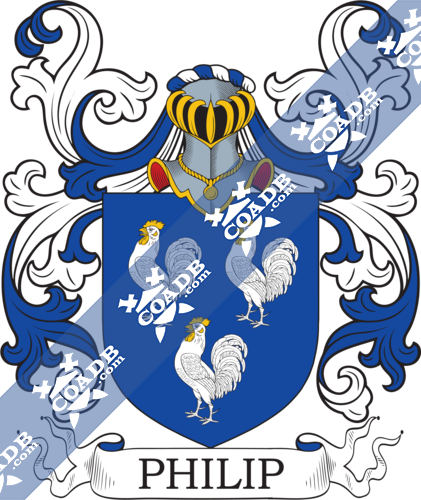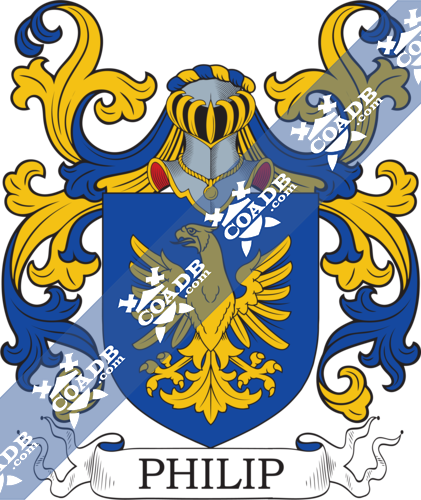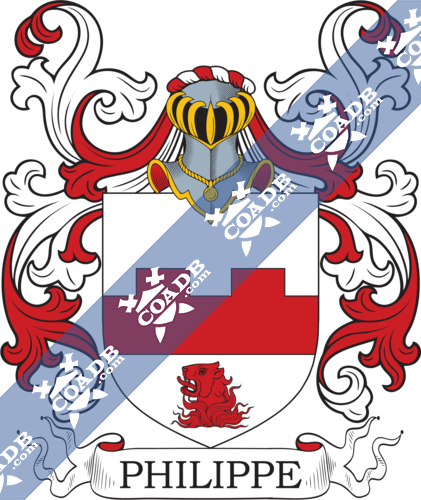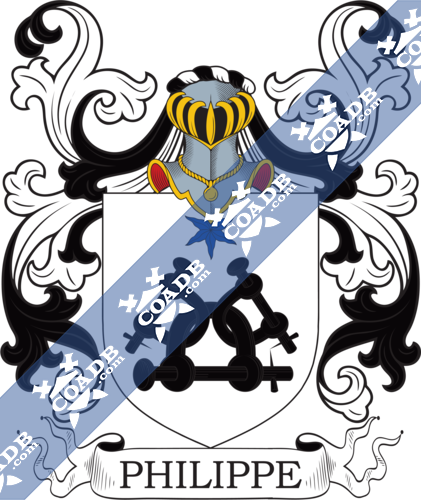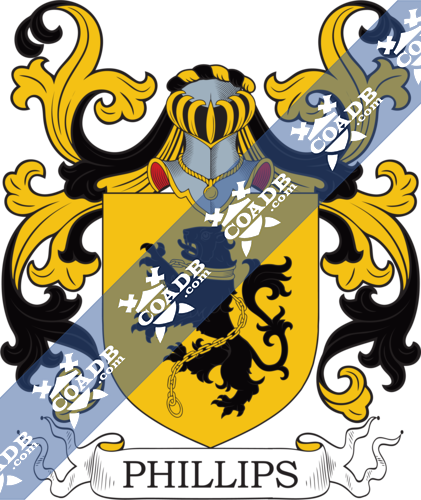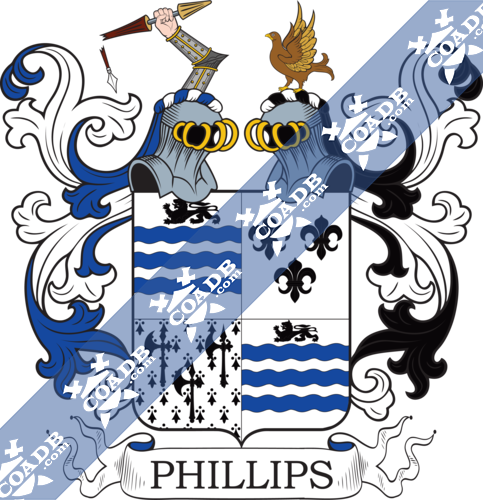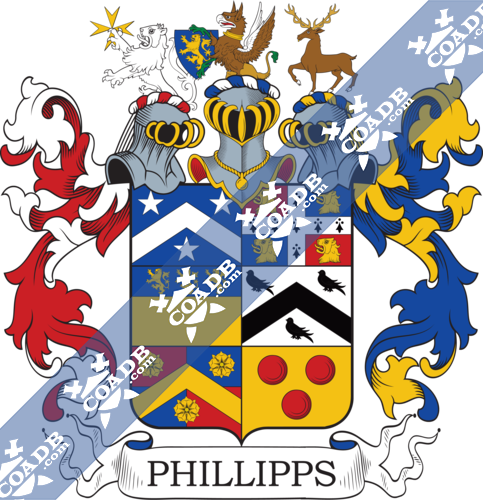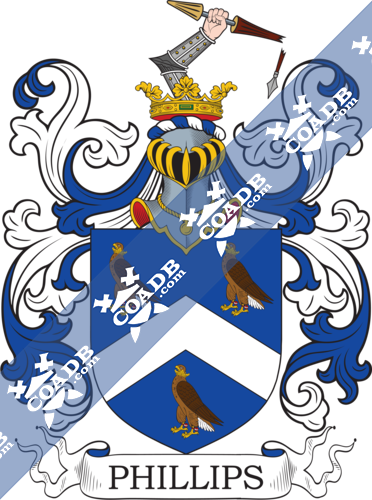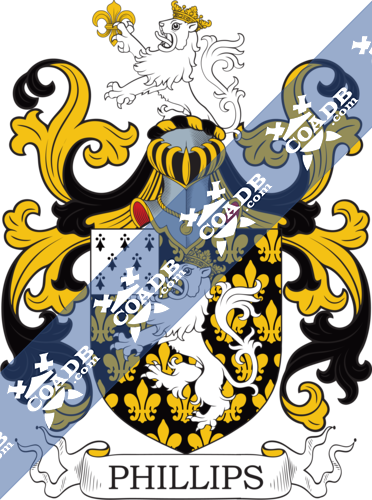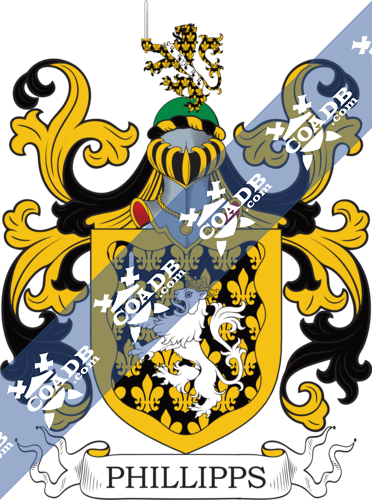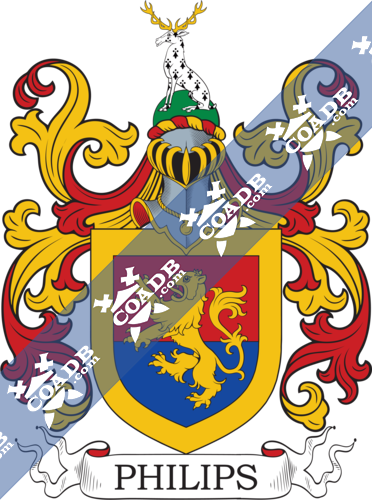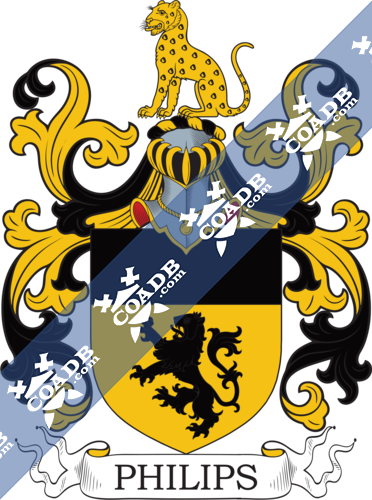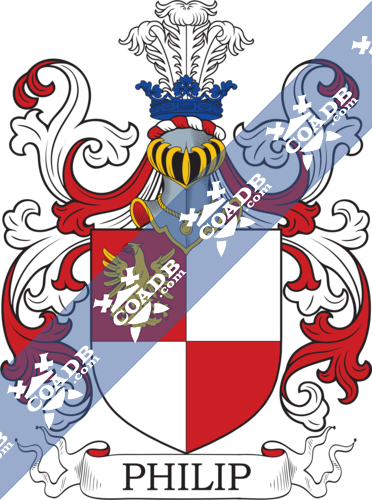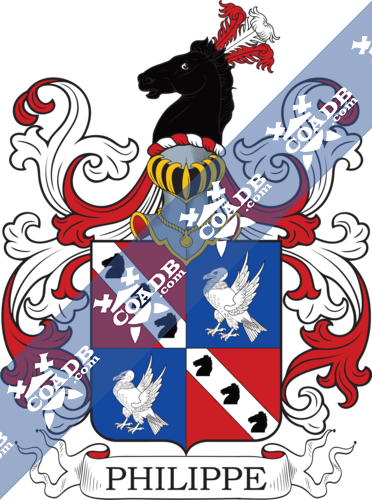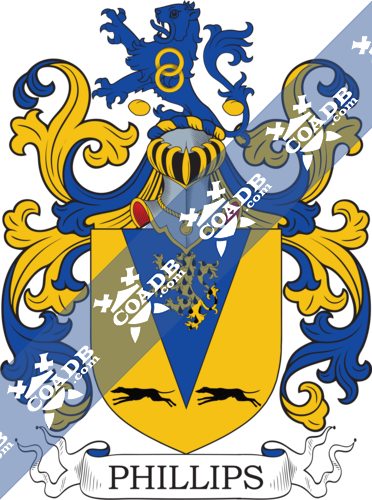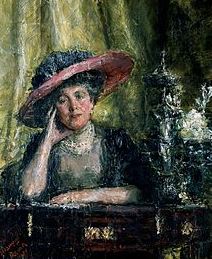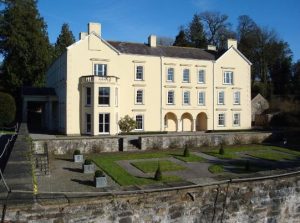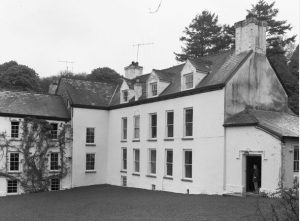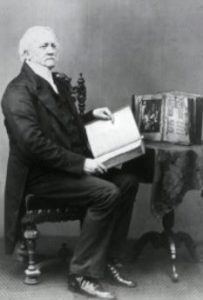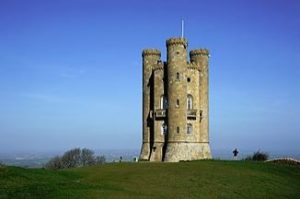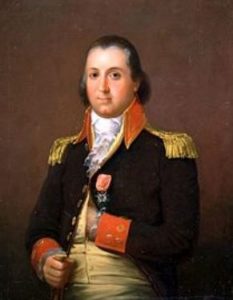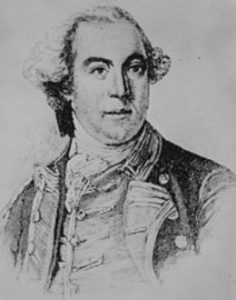Phillips Family Crest, Coat of Arms and Name History

Phillips Coat of Arms Gallery
Don’t know which Coat of Arms is yours?
We can do a genealogical research. Find out the exact history of your family!
Learn MoreSurname Name Meaning, Origin, and Etymology
This is a baptismal or patronymic surname meaning “the son of Philip”, deriving from the personal (first) name Philip, an ancient Greek male given (originally Philippos) named meaning “horse-loving” deriving from the compounds philos (loved/dear) and hippos (horse). Given horses were only owned by the rich in classical times, the name was associated by nobility and royalty. It was popularized throughout Chistendom by the Kings of Macedonia (ex. Philip I born in 640 BC and Philip II born 359 BC, the latter being the father of Alexander The Great) as well as one of Christ’s Twelve Apostles (Philip the Apostle born in 80 AD from Antolia who preached in Greece, Syria, and Turkey). Notably, the name was born by five different kings of Spain and six kings of France.
The name made its way into medieval England after the Norman Conquest of 1066 AD, where it was spelled as Filippus in Danelaw documents in county Lincolnshire and as “Philipus in the Gilbertine Houses Charters of Lincolnshire, circa 1150 AD”. Another source asserts this last name was first found in Kent, England where legend states the family descended from Maximum, the Roman Emperor and King of Britain in the fourth century AD, and that the family was later pushed into Wales by invading Saxons where they claim descent from Tudwal (born 528 AD) who was a descendant of the First King of Wales, Rhodri Mawr (820-878 AD). The name was also present in Prussia and the Netherlands in early times.
This page serve as an excellent resource and authority not only on the over 80 Phillips coats of arms or “family crests” (an erroneous and slightly misleading term, see disclaimer at the very bottom of this page), but also the Phillips family history, Phillips family tree, genealogy, and ancestry, as it is fairly comprehensive compared to other pages on the internet on this heraldic and genealogical topic for this surname. This is a good resource for the Philips Coat of Arms, Philips Family Crest, Phillip Coat of Arms, Phillip Family Crest, Philip Coat of Arms, and Philip Family Crest.
The earliest known ancestor of this family (according to wikitree.com) was Artchorp mac Cairebe who was born in Ireland around 300 AD. The last section of this page contains one pedigree of the Phillips family tree from him.
Spelling Variations
Common spelling variants or names with similar etymologies include Phillip, Philip, Philipp, Philipps, Philippe, Phillipps, Philipp, Philip, Philipe, Philipe, Phelippe, Phillip, Philips, Fillups, Fulop, Pilip, Fillip, and others. The first name also has several variants such as Phill, Flip, Feli, Philly, Pip, Pep, or Pippo. The female version is Philippa or Philippine. As a font name, it became less popular after the reigns of Queen Mary and Elizabeth for patriotic reasons ( because Philip II of Spain was married to Queen Mary and both were Catholic). The French first name is Philippe. Foreign equivalent/similar surnames include Philippus (Norse), Philipp/Philipsen (Dutch), Phlups (Flemish), Philp (Swedish), Filippi (Italian), and Filipowicz (Poland).
Popularity & Geographic Distribution
The last name Phillips ranks 47th in popularity in terms in the United Status as of the 2000 Census. The name ranks particularly high in the following eleven states: Tennessee, Alabama, Arkansas, North Carolina, Ohio, Michigan, Indiana, Oklahoma, West Virginia, Delaware, and Alaska.
The surname Phillips frequency/commonness ranks as follows in the British Isles: England (50th), Scotland (165th), Wales (17th), Ireland (454th) and Northern Ireland (205th). In England, it ranks highest in counties Cornwall and Hampshire. In Scotland, it ranks highest in Orkney. In Wales, the surname Phillips it ranks highest in counties Pembrokeshire and Carmarthenshire. In Ireland, it ranks highest in Mayo. In Northern Ireland, it ranks highest in county Londonderry.
The name is also present throughout the remainder English speaking world: Canada (99th), New Zealand (48th), Australia (56th), and South Africa (222nd).
The 1890 book Homes of Family Names by H.B. Guppy, states the following in regard to this surname: “Limiting our attention in the first place to the distribution of Phillips, the commonest form of Philip, we observe that it is confined to Wales and to the part of England south of a line drawn from the Humber to the Mersey, being by far the most numerous in the western half of this area, including Wales, and being much less frequent in the eastern part. Its great home is in South Wales and Monmouthshire, but it is also frequent in Herefordshire, Staffordshire, Cornwall, and Devonshire If we include the several other forms of the name, we find that Philip in its various shapes is still mainly confined south of the line above given, the Phillipsons of Northumberland being the only representatives of the name in the north of England. Philips is not an uncommon name in different parts of Scotland. It will also be remarked that the main features of the distribution are the same, its comparative scantiness in the eastern half of its area and its frequency in the western half, including Wales. In some counties the contractions and corruptions of Philip often take the place of Phillips, the commonest and least altered form, and are associated with it in others. Thus, the frequency of the name of Phelps gives Somerset a pre – eminence that it would not have obtained from Phillips alone. Phelps and Phipps similarly raise the counties of Gloucester and Worcester considerably in the scale. The absence or rarity of Phillips in Warwickshire and Northamptonshire is supplied, or compensated for, by Phipps; and Cornwall receives from Philp a further lift in position. Taking all the forms of the name of Philip together, we find that they distinguish different regions and counties in the following order: first comes South Wales and Monmouthshire, then Cornwall and Gloucestershire, then Herefordshire and Worcestershire, then Staffordshire, and after it Devon and Somerset There are a few distant derivatives of the names of Philip, which I think should be separately treated, to wit, Philpot and Philpots, which are chiefly south of England names. Phippen or Phippin is a Somerset form. However, I am now entering into debatable ground, and can only here remark that the more distant derivatives of Philip do not affect the main features of its distribution already discussed. The Philippos of Norfolk and Suffolk I have not included, there being something suspicious, indicating an independent origin, in the terminal o.”
The spelling variants rank as follows in the 2000 US Census: Philips (4,796th), Phillip (5,352nd), Philip (6,779th), Philipp (15,451st), Philipps (18,283rd), Philippe (20,036th), Phillipps (49,333th). The following variants do not rank in in the top 152,000 names: Philipp, Philip, Philipe, Philipe.
Heritageregistry.net states the following in regard to the names roots in early colonial America: “The Wales Phillips family is the founding root family of the Massachusetts Phillips and New Jersey families. A branch later, via pathways through Somerset England, were signers of the First and Third Charters of Virginia, and thus founding the Phillips of Virginia, North Carolina, and beyond”. The same source also states “From the 15th to the 19th centuries the Philippses of Picton Castle were the most powerful family in Pembrokeshire, exercising tremendous political, social and economic influence over all aspects of local life”.
Early Bearers of the Surname
The Hundred Rolls of 1273 AD, a census of Wales and England, known in Latin as Rotuli Hundredorum lists four bearers of this surname: Simon filius Philippi (Kent), Henry Phelipe (Norfolk), Alicia Philippes (Huntingdonshire), and Ellis filius Philip (Huntingsonshire). The Poll Tax of Yorkshire in 1379 AD lists one bearer of this last name: Cecilia Philipp.
History, Genealogy, and Ancestry
The famous genealogist Bernard Burke’s book “The Landed Gentry” and “Peerage and Knights” discusses several landed/noble branches of the Phillips and Philips family, which are summarized below. More details and Phillips pedigree can be obtained from his books.
Philipps of Mabws and Dale Castle
John Philipps Allen Lloyd-Philipps Esquire of Dale Castle in Pembroke, Wales, and of Mabws in county Cardigan, was Justice of the Peace, Deputy Lieutenant, and High Sheriff in 1844. He was born in 1802 and he married Charlotte Caroline, daughter of Captain William Barlet, and had five issue her: John Allen (Justice of the Peace, Colonel Cardigan Militia, Captain in 82 Regiment, married Elizabeth Jones), Faulkonor Cecil, Charlotte Maria Carleton (married Henry Mathias of Haverford West), Elizabeth Mary (married Robert Dudley Ackland of Boulston), and Mary Frances (married Captain John Edwin Corner). He was born with the patronymic Lloyd and he assumed the surname Phillips upon the demise of Richard, Lord Milford, under the will of James Philipps, Esquire of Pent Park, brother of Mary Llyod, his great-great-grandmother. Burke traces the lineage/ancestry back to Tudwal Gloff, 4th son of Rhodri Mawr, King of Wales. The Philipps Coat of Arms (mistakenly called the Philipps Family Crest) is has the following heraldic blazon: Argent, a lion rampant sable ducally gorged and chair or. Crest: A lion as in the arms.
Philipps of Picton
Charles Edward Gregg Philipps was an Esquire of Picton Castle in county Pembroke, Wales who was Justice of the Peace, Lord Lieutenant and Custos Rotulorum of Haverfordwest, as well as Captain of the Pembroke Yeomanry Cavalary. He was the son of Edward Fisher of Spring Dale in county York and Jane Gregg of Lisburn and Colerain in Ireland, who assumed the surname Philipps, in lieu of Fisher, by royal license in 1876 in compliance with the testamentary injunction of his father in law. He was born in 1840 and in 1868, he married Mary Philippa, daughter and co-heir of Reverend James Henry Alexander Philipps of Picton Castle and he had six children with her: Henry Erasmus Edward (born 1871), George William Fisher (born 1878), Ethel Philippa, Hilda Mary, Edith Catherine, and Mabel Gable. The branch of the Philipps family tree from Picton Castle in a line of great antiquity in the south of Wales, and descends from Cadifor ap Collwyn, Lord of Dyfed in county Pembroke, known as Cadifor Vawr (the Great) who died in 1089 AD. Thomas AP Philip of Hyslant in county Carmarthen, a descendant of Cadifor, who married Jane, daughter and co-heir of Sir Henry Donne, of Picton (who was the son of Owen Donne of Muddlescombe and Katherine Wogan of Picton Castle, lineally descended from the lords of Picton) and thus he acquired the estate of Picton. The great grandson of their marriage with Sir John Philipps, 1st Baron of Picton Castle, so created in 1621. He married Anne, daughter of Sir John Perrott, and he had issue with her: Sir Richard, Walter, Hugh (ancestor of Philipps, Bart of Picton), Dorothy (married France, 1st Viscount Valentia, ancestor of the Earls of Anglesey and Mount Norris), Lettice (married John Owen of Trecone), Jane (married James, 1st Viscount of Claneboy), Elizabeth, Mary (married John Scourfield), Olive (married Sampson Lort of Stackpole) and Francis (married Sir Hugh Owen, 1st Baronet of Orleton). The eldest son was Sir Richard Philipps, 2nd Baronet of Picton, married Elizabeth, daughter of Sir Erasmus Dryden, 1st Baronet on Canon Ashby, with whom he had two issue: Sir Erasmus and Frances (married James Philipps of Tregibbie in county Cardigan). The Philipps Coat of Arms (mistakenly called the Philipps Family Crest) is has the following heraldic blazon: Quarterly, 1st and 4th, argent, a lion rampant sable gorged with a ducal coronet, and therefrom a chain reflected over the back or, for distinguished in the centre chief point a cross crosslet of the second, for Philipp; 2nd and 3rd, argent, on a chevron gules three trefoils slipped of the field, in chief as many fleur-de-lis of the second, for Fisher. Crest—1st, Philipps: A lion rampant gorged and chained as in the arms, charged on the shoulder (for distinction) with a cross-crosslet or; 2nd, Fisher: in front of a bulrush erect a kingfisher proper resting the dexter claw on a fleur-de-lis or.
Philipps of Aberglasney
John Walters-Phillips was an Esquire of Aberglasney in county Carmarthen, Justice of Peace and Deputy Lietuenant, as well as Hugh Sheriff in 1841. He was born in 1787 and in 1817 he married Ann, daughter of Thomas Bowen of Wann Ifor, and they had three issue: Bridget Jane (married Cecil Anson Harris), Mary Ann (married John Pugh Pryse), and Elizabeth Frances (married Frederick Lewis Lloyd Philipps). He succeeded his maternal uncle, Thomas Philipps, Esquire of Aberglasney in 1824 whereupon he acquired the manor and estate and surname of Philipps. His lineage is traces back to David Walters, Gentlemen of Perthygerant county Cardigan, son of John Walters. This branch of the Philipps family tree bore the following heraldic arms: Quarterly, 1st and 4th, or, a lion rampant sable, between two fleurs-de-lis in chief az. and a stag’s head erased in base gules, for Philipps; 2nd and 3rd, gules three snakes interlaced between two spears’ heads erect in chief, and a rose in base argent, barbed and seeded proper for Walters. Crests—1st, A lion rampant sable, holding between the fore paws an escutcheon or, thereon three snakes interlaced proper, the dexter hind-paw resting on a fleur-de-lis also or, for Philipps ; 2nd, An eagle displayed ermine the body entwined by two snakes respecting each other proper, and holding in each claw a rose, gules slipped and leaved, vert.
Philipps of Cwmgwilly
Grismond Philipps was Esquire of Cwmgwilly in county Carmarthen and Justice of the Peace and Deputy Lieutenant, as well as Captain of the 23rd Regiment. He was born in 1824 and in 1854, he married Marianne, daughter of Major Thomas Bowen, of Pantyderi in Pembroke, and had children with her: Grismond (1867), John Picton (1870), and Catherine Elizabeth (1877). He was the son of Grismond Philipps, Esquire of Cwng, by Catherine his wife, daughter of Thomas Warlow of Castle Hall. The Philipps genealogy can be traced back to the year 1677. Several members of the family were High Sheriffs and Members of Parliament. Grismond Philipps was Esquire of Cwmgwilly, son of George, was a Member of Parliament, who married Anne, daughter of John Ball and had issuer with her: Grismond, John George (went to India), William, Cecil Eliza (married General Baillie), and Catherine Anne Prudence (married W.R.H. Powell) This branch of the Philipps family tree bore the following coat of arms (erroneously called a “family crest”): Argent, a lion rampant guardant sable ducally gorged and chained or. Crest: A lion rampant as in the arms.
Philips of the Heath House
John Capel Philips was Esquire of The Heath House in county Stafford and Newlands, counties Gloucestershire who was Justice of the Peace and Deputy Lieutenant who was born in 1831 and in 1857 married Fanny Esther Flower, daughter of Henry Jeffrey, 5th Vissount of Ashbrook, and had five issue with her: Burton Henry (1858), John Augustus (1861), Montagu Capel (1875), Frances Margaret, and Bertha Mary. Burke traces the Philips genealogy or linceage back to Francis Phylyppe, Esquire of Neyther Teyne in the parish of Checkley, county Stafford, who died during the reign of King Edward VI of England and was the great grandfather of Anthony Philips, Esq. In 1617, Anthony married Elizabeth, daughter of Edward Rawlins of Tean. He died in 1648 and was succeeded by his son Richard Philips, Esq. who in 1649, married Christobel, daughter and co-heir of Robert Whetall, of Bignoll Hill, county Stafford. He died in 1685 and was succeeded by his son, Nathaniel Philips, Esquire Esq. of The Heath House, in Checkley, who was born in 1659, who married Elizabeth in 1690,daughter and co-heir of John Stubbs, Esquiore of The Shaw, county Stafford, by Ellen his wife, daughter of John Jervis, Esq. of Chatkill and Meaford, and had three issue with him: John, Richard (ancestor of Phillips-Jordell of Yeardsley Hall in county Chester, the seat of said family), and Nathaniel (ancestor of Philips of Bank Hall). He died in 1737 and was succeeded by his eldest son John. John Philips was Esquire of The Heath House, Lord of the Manors of Upper Teane, Nether Teyne, and Checkley who was born in 1695. In 1722, he married Susanna, daughter and co-heir of John Burton of Derby, and had three issue with her: John, Nathaniel (of Stand, married Elizabeth Hibbert), and Thomas (of Sedgley, ancestor of Philips Baronet of Weston in county Warwick). He died in 1777 and was succeeded by his son John Philips who was born in 1724 and married Catherine, daughter of William Turner of Upper Teane, but he died without issue and was succeeded by his newphew: John Philips. This branch of the Phillips family tree bore the following heraldic arms and crest: Per pale argent and sable within an orle of fleurs-de-lis arg. a lion rampant erminois, ducally crowned, and holding between the paws a mascle or, a canton arm. Crest: A demi-rampant erminois, collared sable ducally-crowned or, holding between the paws a fleur-de-lis arg. within a mascle gold.
Philips of Heybridge
John William Philips was Esquire of Heybridge in county Stafford, England, as well as Justice of the Peace, Deputy Lieutenant, and High Sheriff in 1861. In 1852, he married Adelaide Louisa, daughter of Edward Buller of Dilhorn Hall, and had four issue with her: William Morton (1852), Robert Edward (1860), Evelyn Adelaide, and Nina Margaret. In 1867, he married Olivia, daughter of William Dodsworth and had four issue with her as well: John Cyril (1868), Arthur Dodsworth (1869), Lewis Francis (1870), and Maud Laetitia. This family is a branch of the family tree of Philips of Heath House. Robert Philips, Esquire of Hyebridge in county Stafford, was the fourth son of John Philips and Margaret Robinson and in 1825, he married Laetitia, the youngest son of William Hibbert of Hare Hill in county Chester, and he had five issue with her: John William, Edward (born 1832, married Emily Mather and had four children with her), Herbert Philips (born 1834, married Ellen Josephine Langton), Ellen Laetita, and Frances Elizabeth (married Reverend Thomas Wynter Blathwayt, Rector of Durham). This branch bore the same coat of arms as Philips of Heath House.
Philips of Welcombe
Robert Needham Philips was an Esquire of Welcombe in county Warwick, and the Park Manchester who was Justice of the Peace, Deputy Lieutenant, and High Sheriff in 1857, and Member of Parliament for Bury who was born in 1815. His first wife was Anna Maria, daughter of Joseph Brooks Yates, and he had the following children with her: Caroline (married George Otto Trevelyan), and Margaret (married William Edward Price of Tibberton Court). His second wife was Mary Ellen, daughter of John Ashton Yates (a member of Parliament from Lindon) and had the following children with her: Anna Maria. Burke states this branch of the Philips family tree is part of the Heath House branch. Robert Philips, Esq. of the Park, Mancester, and Snittergeld in county Warwick was born in 1760 and in 1798 he married Anne, daughter of Matthew Needham of Nottingham, and had the following issue with her: Mark, Robert Needham, Mary (married Robert Hyde Gregg of Norcliffe Hall), Mary (married Robert Hyde Greg, Esq. of Norcliffe Hall) Sarah Jane (married J.W. Mylne, Barrister-at-Law), Anna Priscilla, Hester Emily (William Duckworth, of Pendleton), Isabella, Elizabeth Lucy, Jessy, Clara Octavia, and Caroline. The eldest son Mark was Esquire of Snitterfield and Welcome was a Member of Parliament for Manchester (from 1832-1847) who was born in 1800 and died in 1873, whereupon he was succeeded by his brother. This branch bore the same coat of arms as Philips of Heath House.
Philips of Bank Hall
Francis Philips, Esquire of Bank Hall in county Lancaster and Lee Priory, county Kent, was Justice of the Peace and Barrister-at-Law who was born in 1830 and in 1856 he married Caroline Mary, fourth daughter of Reverend Kenrick Prescot, Rector of Stockport. This family is a branch of the Philips family tree of Philips of Heath House. This branch bore the same coat of arms as Philips of Heath House. Nathaniel Philips, Esquire of Manchester, third son of Nathaniel Philips and Elizabeth Stubbs, who was born in 1693 and in 1729 married Elizabeth, daughter and co-heir of John Burton of Derby. They had the following issue: Narthaniel (born 1730, married Hannah Barrow of Salford) and John. He died in 1776 and was succeeded by his younger son John. John was born in 1734 and was an Esquire who purchased the estate of Bank Hall of Heaton Norris in county Lancaster in 1777. He married Sarah, daughter of George Leig of Oughtrington Hall in Chester), and had the following children with her: John Leigh (of Mayfield, Lieutenant Colonel Commandant 1st Regiment Manchester and Salford Volunteers who was born in 1761 and married April Penny and had issue with her), Henry (born 1792), = distinguished painter), Henry (of Philadelphia, born in 1767, married Sophia Chew, had daughter Sophia who married J.C. Montgomery of Eglinton, New York), Nathaniel George (born 1770), Francis, James (born 1777), Thomas (born 1781), Hardman (lived in Philipsburg, Pennsylvania, born 1784, married Sophia Lloyd), Ann (married John Potter and later Reverend George Hulme), Elizabeth (married Reverend George Leigh), and Sarah (married Sir Hungerford Hoskyns, 7th Baronet of Harewood). He died in 1824 and his heir was his fourth son, Francis Philips. Francis Philips was Esquire of Bank Hall, Justice of the Peace, and Deputy Lieutenant who was born in 1771 and in 1792 married Beatrice, daughter of James Aspinhall, a Merchant of Liverpool, with whom he had two sons: Francis Aspinall and Hindley Leight. The Philips genealogy continues for several more generations.
Phelips of Montacute
Burke states the following on the lineage of this family: “without dwelling on the tradition that the Phelips family originally migrated into Somerset from Wales, it is certain that it has been seated in cos. Somerset and Dorset for many centuries, and the muniments of title prove that Thomas Phelipp armiger; was a land-owner and resident at Montacute in 1480. He left two sous, Richard, his heir, and Thomas”. The list of ancestry and pedigree and Phelips family tree goes on for many generations and Burke concludes it with a mention of William Phelips, Esquire of Montacure in Somerset who was Justice of the Peace and Deputy Lieutenant, born in 1823. In 1845, he married Ellen Harriet, daughter of William Helyar and he had two issue with her: Edith Ellen and William Robert (Justice of the Peace, of the 6th Dragoon Guards, born in 1846, married Cicely Grace Augusta, daughter of Frederick Fane of Moles Court). The Phelips Coat of Arms (mistakenly called the Phelips Family Crest) is blazoned as follows in heraldry: Quarterly: 1st and 4th, arg., a chevron gules between three roses of the last seeded and leaved proper; 2nd and 3rd, or, on a chevron engrailed vert three eagles’ heads erased argent. Crest—A square beacon or chest on wheels or, filled with fire proper.
Phelips of Briggins Park
Charles James Phelips was an Esquire of Briggins Park in county Hertford, as well as Justice of the Peace for county Hertfordshire and Essex. He was born in 1821 and 1870 he married Emily Susannah Dunning, daughter of Charles James Dunning, a captain in the British Royal Navy. The lineage traces back to Reverend Charles Phelios who was born in 1765, the son of Edward Phelips of Montacure of Somerset. He married Mary, daughter of Thomas Blackmore of Briggins Park, and with her had ossue: Edward (Lieutnant in 13th Light Dragoons killed at Waterloo), Mary Anne (married her first cousin, John Phelips) and Charles Phelips. Charles was his son and heir, an Esquire of Briggins Park who was born in 1794 and was Justice of the Peace, Deputy Lieutenant, and High Sheriff in 1794. In 1820, he married Caroline Elizabeth, daughter of James Taylor of Wimpole Street, and had issue with her: Charles James, Edward Blatwayt, George Blackmore, Captain William Douglas, Captain Henry Plantagenet Prescott, Alfred Plumer Ward, Arthur Robert, Frances Emma (married William Philip Honywood of Marks Hall in county Essex), and Caroline Mary (in 1851, he married David Ward Chapman, son of David Barclay Chapman, and had issue with her). The Phelips Coat of Arms (mistakenly called the Phelips Family Crest) was the same arms as that of Phelips of Montacure discussed above.
Baronet Phillips
Sir Robin Francis Phillips was born in 1940 and succeeded his father in 1944, becoming the 3rd Baronet. The lineage traces back to Sir Lionel Philips, 1st Baronet, who was created so in 1912, and was a Deputy Lieutenant and High Sheriff in 1903. He was the son of Philip Saunders Phillips of London, a merchant. Lionel was prominent in the Transvaal gold mining industry and was involved with the political development of South Africa. He was arrested in 1896 and condemned to death, but was released. He was born in 1855 and in 1885, he married Dorothea Sarah Florence Alexandra, daughter of Albert Frederick Ortlepp of Colesburg, Cape Colony. He had three children with her: Harold Lioned (born 1886, Captain in the Royal Airforece who married Hilda Wildman Hills and served in World War I), Francis Rudolph (Captain of the Surrey Yeomanry, born 1888, married Eileen Cicely Mander in 1920). The Phillips Coat of Arms (mistakenly called the Phillips Family Crest) for this branch is blazoned in heraldry as follows: Or on a pile azure, between two greyhounds courant in base sable, a lion rampant of the first, guttee de poix. Crest: A demi-lion azure, between two nuggets of gold and charged with two annulets interlaced palewise or. Motto: Veritas vincet.
MacPhillips Family of Ireland
The book “A genealogical history of Irish families states the following: “MacPhillips family is of Norman origin, being a branch of the Burkes who took the name of MacPhillip from the founder of the family, Philip de Burgo. They possessed large estates in the barony of Ccstello, in the present County of Mayo, their principal seat being at Cloonmore. They had also a castle at Doon, a short distance east of Westport in the same county. Another branch of this family settled in the County of Monaghan. The McPhillips contributed many eminent men to the Irish hierarchy, among whom may be mentioned the Rev. Thomas McPhillip, formerly of Cleenish, Diocese of Clogher. He was educated in France, and was a man of varied learning and profound erudition. His brother, William McPhillips, was a man of much influence in his locality and exercised it on many occasions for the benefit of the people. He was gifted with great mechanical ingenuity, and had he a larger sphere of action would have left an enduring mark”. The name developed into MacPhilbin as well. One source asserts the name was first found in Connacht, where a man named MacPhilbin was one of the chiefs in that area, then named Sil Amachada (in East Galway).
Early American and New World Settlers
Elmer Phillips was recorded as living in Virginia (“Att West and Sherlow hundred”) in February 1623.
Thomas Phillips was recorded as living in Virginia (“At Chaplains choise”) in February 1623.
Henry Phillips was recorded as living in Virginia (“At Warwick Squeake”) in February 1623.
John Phillips was recorded among the dead in Virginia in February 1623.
Richard Phillips, age 20, came to Virginia aboard the Speedwell of London in May 1635.
Elizabeth Phillips, age 22, came to Virginia aboard the America in June 1635.
James Phillips, age 26, came to Virginia aboard the Transport in June 1635.
Thomas Phillips, age 24, came to Virginia aboard the Assurance in July 1635.
Joseph Phillips, age 28, came to Virginia aboard the Merchant’s Hope in July 1635.
Richard Phillips, age 14, came to Virginia aboard the George in August 1635.
Eliazer Phillips came to Boston in 1679 aboard the Providence.
William Phillips, age 28, came to the Barbados aboard the Falcon in December 1635.
William Phillips, age 17, came to the Barbados aboard the Alexander in May 1635.
Joseph Phillips, age 20, came to the Barbados aboard the Alexander in May 1635.
Mary, daughter of William and Mary Phillips was baptized in December of 1678 in the parish of Christchurch, Barbados.
Thomas Phillips, age 25, came to St. Christopher’s aboard the William & John in September 1635.
William Phillips was among a list of convicted rebels who came to the Caribbean in the late seventeenth century aboard the Jamaica Marchant.
The book Genealogical Guide to the Early Settlers, mentions 45 different bearers of the Phillips surname who lived in early colonial American (primarily in the 1600s). Several, but not all, will be discussed below:
1) Andrew Phillips of Charlestown, married Elizabeth, had issue Andrew, Elizabeth (1657), and Ephraim (1659)
2) Andrew Phillips, likely son of the above, who married Sarah, daughter of Michael Smith of Malden in 1683 and had the following issue with her: Andrew (1687), Ebenezer (1695), and Joanna (1697).
3) Benjamin Phillips, Marshfield, who married Sarah Thomas, likely daughter of Nathaniel, in 1682.
4) Caleb Phillips of Roxbury, who married Elizabeth and had issue Caleb (1682), John (1684), Elizabeth (1685), Mary (1688), and Ebenezer (1690)
5) Charles Phillips of Lynn, had issue David (1656), Abigail, John, George, and John
6) Daniel Phillips of Newtown, Long Island, 1686, brother of Theophilus, town clerk, may have served in Gallup’s company against Quebec, Canada in 1689
7) David Phillips of Milford, around 1657
8) George Phillips of Watertown, the first minister in said town who came aboard the Arabella with Governor Winthrop in 1630, bringing with him son Samuel and wife Elizabeth, and perhaps Abigail. He was the son of Christopher, born in 1593, at Rainham, St. Matins, bear Roughman. He had issue named Zarobabel, Jonathan, Theophilus, Amabel, Ephraim, Obadiah, and others.
9) George Phillips of Dorchester, a freeman in 1631, perhaps came aboard the Mary and John and moved to Windsor. He had no children.
10) Henry Phillips of Dedham, freeman in 1639, who was in an artillery company in 1640. He married Elizabeth Brock and later Ann Hunting and had issue named Eleazer, Hannah, and Abigail. His third wife was Mary, daughter of John Dwight, with whom he had the following issue: Nathaniel, Eleazur, Henry, Timothy, Mary, Samuel, Elisa, Jonathan, Mehitable, John, John, and Elizabeth.
11) Henry Phillips of New London, listed on a tax record in 1667
In Canada, some of the earliest immigrants bearing this name include Diana and Eleonor Phillips who came to Nova Scotia in 1750. In Australia, one of the first bearers of this name was Bat Phillips, a convict from Middlesex, England who came to New South Wales (then a penal colony) aboard the Agamemnon in April of 1820. In New Zealand, several bearers of this name came in 1941 to Wellington aboard the Lord William Bentinck: William, Catherine, John, Fanny, and Henry Phillips.
Early Americans Bearing the Phillips Family Crest
Charles Bolton’s American Armory (1927) contains three for this surname:
1) Arg a lion sa ramp sa gorged [gu?] and chained [or?] Crest: a demi-lion ramp guard. Motto: Omnes benevolentia. Bookplate James Phillips.
2) Or a lion ramp sa gorged and chained Crest: a lion sejant sa gorged and chained. Bookplate Phillips Academy, Andover, Mass. Another with azure field and a chief erm, the crest a demilion ramp guard.
3) Or a lion ramp gorged sa. Impaling: Sa on a chev or [arg?] 3 sprigs of broom [vert]. On a canton or a spear head erect [az] embrued [gu] (Bromfield) Crest: a lion pass sejant. Engr. on flagon from Hen. William Phillips, 1804. Old South Ch., Boston. Old Sil. Am. Ch., p. 56.
Crozier’s General Armory (1904) contains two entries for this name:
1) Reverend George Phillips of Watertown, Massachusetts, 1630, from Boxford. Azure, a lion rampant sable, ducally gorged and chained or. Crest: A lion as in the arms. Motto: Ducit amor patriae.
2) Mrs. William E. Phillips of Baltimore Maryland. Same Arms as Richard Gundry of Maryland: Argent two lions passant guardant, in pale azure. Crest: A demi lion holding in the dexter paw a sword all or.
Matthew’s American Armoury (1907) and Bluebook contains one entry for this name: Henry Byron Phillips was born in Summit, Rhode Island in 1850. He married Henrietta, daughter of William F. Coper, Mayor of Santa Cruz and had three issue with her: Stanley Cooper, Alice Willetta, and Edith Henrietta. Arms: William: Azure, a lion rampant gules by nine pheons or. Lathame: Or, on a chief indented azure three plates. Arnold: Gules, a chevron ermine between three pheons or. He was the son of Albert Alexander Phillips of Scituate Rhode Island and Almira Rice. The author states he desends from Michel and Barbara Phelips (or Felipe) who descended from “ancient Irsaelitish stock of Spain, viara Portugal and Holland, of Newport, Rhode Island, 1668”.
Mottoes
We have identified 25 Phillips family mottoes (and mottos for its spelling variants such as Philips, Phillip and Phillip)
1) Mens conscia recti (A mind conscious of rectitude)
2) Cwell angau neu chivilydo or Gwell angau na Chywilydd (Better death than dishonor)**
3) Animo et fide (By courage and faith)
4) Spero meliora (I hope for better things)
5) Ducit amor patriae (Patriotism leads me)**
6) Pro Deo et rege (For God and King)
7) Deus, patria, rex (God and the Fatherland)
8) Quod justum non quod utile (What is just, not what is useful) (of Garedon Park)
9) Ce m’est egal (It’s all the same to me)
10) Nil nisi honestum (Nothing unless honorable)
11) Simplex munditiis (Plain with neatness) (Philips of Somerset)
12) Fy Nuw a Chymry (My God and Wales)
13) Virtute et fide (By virtue and faith)
14) Vivis sperandum (Where there is life there is hope)
15) Sors omnia versat (Fate whirls everything about)
16) Non dormit qui custodit (Who guards doesn’t sleep)
17) Adjuvante Deo (God my helper)
18) Arr dduw y Gyd (All depends on God)
19) Auspice Deo extuli mari (God being my leader, I brought him out to sea)*
20) Erectus non elatus (Exhalted, but not elated)
21) Flecti non frangi (To be bent not to be broken)
22) Quod tibi vis fieri facias (Do what you wish to be done to yourself) (Philipse)
23) Per mutlos annos (Through many years)
24) Omnes benevolentia (All goodwill)
25) Pro aris et focis (For God and country or For altars and hearths)
26) Veritas vincet (Truth prevails)
27) Persevere
*Upon a mount vert, in front of a Newfoundland dog. sejant, reguardant ppr. an Escutcheon ar. thereon, in base, waves of the sea, and floating therein a naked man, the sinister arm elevated also ppr. The crest and motto are borne in consequence of the life of William Phillips, Esq., of Cavendish Square, having been saved from drowning in Portsmouth harbour by a strange dog; this canine preserver was received into the family and passed the remainder of his days in ease and com fart. John William Phillips-Marshall, now deceased, was one of the Admirals of our Royal Navy ; he was a natural son of William Phillips. Esq., of Cavendish ppr (whose life was saved as stated above). His brother (Phillips) a clergyman, Vicar of Eling, Hants, also bore the same crest and motto.
**A line from the ancient Roman poet Virgil (from the poem Aenied?)
***Motto of the Welsh Regiment
Grantees
We have 83 coats of arms for the Phillips surname depicted here. These 83 blazons are from Bernard Burke’s book The General Armory of England, Ireland, and Scotland, which was published in 1848. The bottom of this page contains the blazons, and in many instances contains some historical, geographical, and genealogical about where coat of arms was found and who bore it. People with this last name that bore a Phillips Coat of Arms (or its numerous spelling variants) include:
1) Philip-Broade after Stanier, Francis, of co. Staff., [1858]
2) Philipps to Lee, William, of co. York and Berks., [1761]
3) Philipps, late Mansel, Richard, of Wales, [1793]
4) late Grant [Sir Richard Bulkeley Philipps Phillips, Bart.], of Picton Castle, Wales [Roy. Lic, 10 Feb. 1824], [1824]
5) Philipps, Sir Richard Bulkeley-Philipps, Bart., Baron Milfokd [21 Sept. 1847]. Supporters, [1847 ?]
6) Philipps after Walters, . . . ., of Newcastle Emlvn and Aber Glasney, co. Carmarthen, and Bethgeraint, co. Cardigan, Wales, [1826]
7) Philipps, late Lloyd, John Philipps Allen Lloyd Philipps, of Dale Castle, &c., Wales, [1833]
8) late Lloyd, Col. James, of Dale Castle, &c., Wales, [1833]
9) late Gwyther, . . . ., of Picton Castle, co. Pembroke, Wales, [1836]
10) late Fisher [1876], Charles E. Gregg, of Wales, and the Middle Temple, London (Gregg-Philipps. Bart.), 1876.
11) Philipps to Scourfield, of Wales ; Williamston, The Mote, and Robeston Hall, co. Carab., [1863]
12) to Maxnell, Maj. Courtenay, of Coedgaing, co. Carmarthen, Wales. Exemplification of Manx only. [1871]
13) Dursley, co. Glouc. (See Phelps, or rather Purnell.) [1768].
14) Philips to Scott, (Spr.), of nr. Moreton-in-the-Marsh, co. Glouc, reputed dau. of Scott, of Bank Fee House, [1816] Vol
15) Philips, John, of Heath House, co. Staff. Stubbs quartering, [1822].
16) Rev. Gilbert H., M.A., of co. York. Quartering Stubbs and Burton, [1862]
17) Rev. Gilbert H., M.A., of co. York. Quartering Henderson, [1863]
18) Phillipps after March, of co. Dorset. Quartering, [1796]
19) Phillipps, late Winsloe, Thomas, of Collipriest, co. Devon, and Newport House, Camelford, co. Cornw. (Roy. Lie, 8 Nov. 1798), [1798].
20) Phillipps, James Orcbard Halliwell- (s. of Thomas, of Brixton Hill, deed.), F.R.S., of Jesus Coll., Camb., and Lincoln’s Inn, London, 1850, aged 30, 1872.
21) of Lougworth, Lagwardine and Eaton Bishop, co. Hereford, [1831]
22) Phillipps-Flamank, Rev. William [Phillipps], B.A., of Lanivet and Boscarne, CO. Cornw., and Glympton, co. Oxf., [1819 ?]
23) Phillips-Treby, Col. Paul Winslow, R.A., of Goodarnor Plympton St. Mary, co. Devon, 1877,
24) Phillips, Sir Thomas, Bart., of Middle Hill, co. Wore. First grant, [1821]
25) Phillips after Spencer, of Riffhams, Langford Parsonage and Terling, co. Essex. Quarterly Arms, [1809]
26) Phillips, Thomas, of Leeds, co. York.
27) Phillips to Nicholson, William, B.A., of Roundhay, co. York, 1827,
28) Phillips, John, of Hanbury Hall, co. Wore, [16 Feb.] 1825.
29) Phillips, late Brown, Gov. of Penang, nat. s. of Maj.-Gen. Phillips, Gov. of Windsor Castle, and dau., wife of Bignell, 1825.
30) late Brown, Maj.-Gen. Sir Charles, of Lyndhurst, Hampsh., 1825,
31) Phillips, Edward, J.P., of Coventrv. co. Warw., and to the descendants of his father William, deed, 11 July 1835,
32) Maj.-Gen. Sir Benjamin Travell, Knt. [18 Feb. 1858], of Hawldston, co. Pembroke, Wales (s. of Stephen Howell Phillips, Lieut, of Body Guard of Yeomen), 1858.
33) Phillips-Jordell, Thomas, of county Chester and Lancashire, 1868
34) Phillips to Church, Samuel, of Wales (name Church onlv). Church and Phillips quarterly, [1869] Vol.
35) Phillips, Edward Clive Oldnall Long Phillijis, Vice-Consul at Kertch and of Rotherham, s. of Richard Augustus Long Phillips, of Rofherham, co. York, 1876,
36) Phillips to Wolley, . . . ., of Kertch, and Rotherham, co. York, [1876]
37) Phillips, Lionel, of Hohenheim, Braamfontein, South Africa, s. of Philip Saunders [Phillips], 1897,
Notables
There are hundreds of notable people with the Phillips surname. This page will mention a handful. Famous people with this last name include: 1) Stephen Clarendon Phillips (1801-1857) who was a merchant and member of the US House of Representatives from Massachusetts as a member of the Whig and Free Soil Party, 2) Sir Thomas Phillips, 1st Baronet (1792-1872) who was an English antiquary and book collector born in Manchester, 3) Thomas Warton Phillips (1835-1912) who was an Republican member of the US House of Representatives from Pennsylvania who was born near Mount Jackson and was a appointed a member of the US Industrial Commission by President McKinley, 4) Sir Thomas Phillips (1801-1867) who was a Welsh politician, lawyer, and businessmen who was of the Phillips of Llanella House who became the mayor of Newport in Monmouthshire, 5) Wendell Phillips (1811-1884) who was an American abolitionist, attorney, and advocate for Native American rights who was born in Boston, Massachusetts, 6) William Phillips Jr. (*1750-1827) who was born in Boston, MA and became the 10th Lieutenant Governor of Massachusetts, 7) William Phillips (1878-1968) who was a career diplomat from Beverly, MA who was United States Ambassador to Canada, Italy, and Belgium, as well as the Under Secretary of State, 8) General Samuel Cochrane Phillips (1921-1990) who was a United States Air Force General who was the Director of NASA’s Apollo program in the 1960s who was born in Springerville, AZ, 9) Ammi Phillips (1788-1865) who was an American portrait painter active primary in three states: New York, Connecticut, and Massachusetts, 10) Catherine Phillips (1727-1794) who was a Quaker Minister who was a Quaker minister who travel to the British Isles and Holland and was born in Dudely, Worcestershire, England, 11) Henry Frank Phillips (1889-1958) who was a businessman from Portland, Oregon who invented the phillips head (cross head) screw and screw driver, 12) Richard Phillips (1778-1851) who was a British chemist who was born on Lombard Street, London and became a member of the Royal Society, 13) Alban William Housego Phillips (1914-1975) who was an economist from New Zealand who became a professor at the London School of Economics and is best known for the idea of the Phillips curve (inverse relationship between unemployment and inflation), and 14) Keith Anthony Phillips (1959-2016) who was an American professional baseball player in the MLB who was born in Atlanta, Georgie and was a second baseman and shortstop who played for eight different MLB teams (ex. Oakland Athletics, Detroit Tigers).
Phillips Family Tree, Pedigree, & Lineage
The first known ancestor of this family was Artchorp mac Cairebe who was born in Ireland around 300 AD. His son was named Echuid Allmuit mac Artchop who was born in Ireland around 330 AD. He in turn had a son named Corath mac Echuid who was born iaround 370 in Ireland. Below is the direct line of male descent from him (estimated):
Aled Brosc mac Corath (around 400 AD in Ireland)
Tryffin ap Aled Brosc (around 430 AD)
Anonymous ap Tryffin ap Aled Tryffin (around 460 AD)
Anonymous ap Tryffin ap Aled Tryffin (around 500 AD)
Cynan “Cylched” ap Tryffin (around 530 AD)
Cynan “Cylched” ap Tryffin (around 600 AD)
Cynan “Cylched” ap Tryffin (around 630 AD)
Cynan “Cylched” ap Tryffin (around 670 AD)
Cynan “Cylched” ap Tryffin (around 700 AD)
Llywn “Cylched” ap Cynan (730)
Dei ap Llywri (770)
Iop Ap Dei (800)
Arthafad Ap Iop (830 in Dyfed, Camarthenshire, Wales)
Cynan ab Arthafad (870, Dyfed, Wales)
Elgan ap Cynan, Wefl-hwch, Thick Lips (900, Dyfed, Wales)
Rhydderch ab Elgan Wefi Hwch formerly Elgan (930 AD)
Gwyn Rhydderch formerly Ap Rhytherch (970, Dyfed, Wales)
Gollwyn Ap Gwyn (1000 AD, Balean Cuch, Carmarthenshire, Wales)
Lord Cydifor Fawr Fawr,ap Collwyn,ap Gollwyn formerly Fawr,ap Cloowyn,ap Gollwyn (1055 AD)
Bledri Latimer ap Cydifor (1057 AD, Cil Sant, Llanwinio, Wales)
Rhys ap Bledri (1115 AD)
Sir Aron ap Rhys (1165 AD)
Gwilym ap Aron (1200)
Madog ap Gwilym formerly Gwilym
Evan ap Madog formerly Madog
Philip Ap Evan formerly Evan
Meredudd Ap Philip formerly Philip (1360)
Philip Phillips formerly Ap Meredudd (1415, Cilsant Castle, Wales)
Thomas Phillips (1465, Wales)
Sir Owen Phillips (1505 Kidwelly, Wales)
Sir Simon Phillips (1520 Llwyngwair, Pembroke, Wales)
John Phillips (1539 Northamptonshire, Devon)
The aforementioned John married Johann Watters and later Margaret Porter and had the following issue: Nicholas, John Richard, Steven, Christopher, William, Richard, Margaret, John, and Florence.
His son Nicholas was born in 1560 in England. Here is the pedigree from him:
Nicholas Phillips Jr. was born in Dedham, Essex in 1586
Richard Phillips (1635, Wendover, Buckinghamshire)
Caleb Phillips Sr (1659, Wemouth, Suffolk, America)
Caleb Phillips Jr (1682, Roxbury, Boston, MA)
Caleb III (1705, Massachusetts)
Joshua Phillips (born 1735 in MA, married Mary Heaton)
Blazons & Genealogy Notes
2) Phillips – (Newport House, co. Cornwall). Or, a lion ramp. sa. chained of the first. Crest—A lion, as in the arms.
3) Phillips – (Tredrea, co. Cornwall). Az. on a cross engr. or, a torteau betw. fear crosses crosslet fitchee gu.
4) Phillips – (Sir Thomas Phillips, Knt., Q.C.). Sa. a chev. betw. three spear heads ar. Crest—A dragon’s head erased. Motto—Cwell angau neu chivilydo.
5) Phillips – (Winterdyne House, Bewdley, and Hanbury, co. Worcester, and Edstone, co. Warwick; granted, 1825, by Naylcr, Garter, to John Phillips, Esq., of Hanbury, High Sheriff of co. Worcester 1803). Erminois a lion ramp. sa. ducally gorged and chained or, betw. two cross crosslets fitchee in chief and an escallop in base gu. Crest—On a garb, lying fessways or, a lion ramp. sa. ducally gorged and chained of the first, holding betw. the forepaws a cross crosslet gold.
6) Phillips – (Lawrenny, co. Pembroke). Ar. a lion ramp. sa. ducally gorged and chained or, quartering Lort. Crest—A lion, as in the arms. Motto—Animo et fide.
7) Phillips – (Witston House, co. Monmouth). Quarterly, 1st and 4th, gu. three boars’ heads or; 2nd and 3rd, az. a cross betw. four pheons or. Crest—A boar’s head sa. langued gu. ringed or. Motto—Spero meliora.
8) Phillips – (London, 1634). Ar. a lion ramp. sa. collared, chained, and ducally crowned or.
9) Phillips – Az. a chev. or, betw. three falcons close ar. belled of the first.
10) Phillips – (Chelmicke, co. Salop). Or, on a chev. gu. three cocks’ heads erased ar. combed and wattled of the first. Crest—An eagle’s head erased az.
11) Phillips – (Netley, co. Salop). Ar. a lion ramp. sa. collared and chained or. Crest—A lion ramp. as in the arms.
12) Phillips – (co. Salop). Ar. a cross engr. flory sa. betw. four Cornish choughs ppr. Crest—The trunk of a tree lying fesseways and sprouting at the dexter end vert, thereon a Cornish chough ppr.
13) Phillips – (Yeovil, co. Somerset). Ar. a lion ramp. sa. collared and lined or. Crest—A lion sejant sa. collared and lined or.
14) Phillips – Az. a lion ramp. sa. ducally gorged and chained or. Crest—A lion, as in the arms. Motto—Ducit amor patriae.
15) Phillips – Az. a chev. ar. betw. three falcons ppr. ducally gorged, beaked, and membered or. Crest—Out of a ducal coronet or, an arm embowed in armour, the hand holding a broken spear ppr. powdered with fleurs-de-lis gold.
16) Phillips – Sa. semee-de-lis or, a lion ramp. ar. ducally crowned of the second a canton erm. Crest—A demi lion crowned as in the arms, holding a fleur-de-lis or.
17) Phillips – Vert three roses in pale ar. betw. two flaunches of the last. Crest—A horse pass. erm. gorged with a chaplet vert.
18) Phillips – Ar. a chev. betw. three roses gu.
19) Phillips – (Ireland; granted in 1600). Barry wavy of six. az. and ar. on a chief of the last a lion pass. sa. collared or. Crest—An arm embowed in armour ppr. charged with a fleur-de-lis gold, purlled or, grasping a broken spear also ppr.
20) Phillips – (Mount Rivers, co. Tipperary; confirmed by Betham, Ulster, to Richard Edward Phillips, Esq.). Quarterly, 1st and 4th, ar. three bars wavy az. in chief a lion pass. sa., for Phillips; 2nd, ar. three fleurs-de-lis sa., for Stumbles; 3rd,, erm. three battleaxes sa., for Weekes. Crests—1st: An arm embowed in armour, garnished or, grasping a broken tilting spear ppr.; 2nd: A cock grouse rising ppr. Motto—Pro Deo et rege.
21) Phillipps – (Eaton Bishop, co. Hereford; descended, according to tradition, from a junior branch of the family of Philipps, of Picton Castle; the first settler in co. Hereford, Owen Phillipps, younger brother of Johm Phillipps, of Kilgainvin in Disserth, co. Radnor, was living 1595). (Longworth, co. Hereford; descended from Phillipps, of Eaton). (Bryngwyn, co. Hereford; descended from Phillipps, of Eaton). Quarterly, 1st and 4th, or, a lion ramp. sa. collared and chained of the first, on a bordure of the second eight cross crosslets gold, for Phillipps; 2nd and 3rd, erm. three ravens ppr. each standing on a mount vert, for Ravenhill. Crest—A demi lion sa. collared and chained, holding betw. the paws a leopard’s face jessant- de-lis or.
22) Phillipps – (Middle Hill, co. Worcester, bart., extinct). The Arms granted to Sir Thomas Phillipps, F.R.S. and F.S.A., on the creation of the baronetcy were: Sa. flory or, a lion ramp. ar. ducally crowned gold, and holding in dexter forepaw a sword erect ppr. all within a bordure wavy of the second. Crest—On a mount vert a lion ramp. sa. semée-de- lis or, charged with a bendlet wavy erm. and holding in dexter forepaw a sword, as in the arms. Sir Thomas Phillipps subsequently obtained a fresh grant, viz., Ar. a lion ramp. sa. flory and collared and chained or, in dexter paw a sword erect ppr. in a bordure wavy of the second. Motto—Deus, patria, rex.
23) Phillipps – (exemplified to James Orchard Halliwell, Esq., now of Middle Hill, co. Worcester, on his assuming, by royal licence, 1872, the surname of Phillipps only, in right of his wife, Henrietta Elizabeth Molyneux, eldest dau. of the late Sir Thomas Phillipps, Bart., of Middle Hill). Ar. a lion ramp. sa. ducally gorged with chain reflexed over the back or, holding in the dexter paw a sword erect ppr. a canton (for distinction) of the second. Crest—On a mount vert a lion ramp. sa. ducally gorged and chain reflexed over the back or, holding in the dexter paw a sword erect ppr. charged on the shoulder (for distinction) with a cross crosslet gold.
24) Phillipps – (Garendon Park and Grace Dieu Manor, co. Leicester; Charles March Phillipps, Esq., of Garendon Park, High Sheriff in 1825, and formerly M.P. co. Leicester, was son and heir of the late Thomas March, Esq., of More Critchell, co. Dorset, who took the surname and arms of Phillipps, and subsequently assumed the arms and crest of Lisle, in right of his mother, Susan Lisle, dau. and co-heiress of Charles Lisle, Esq., whose family Mr. March Phillipps represented. See De Lisle). Quarterly, 1st, az. a chev. betw. three mullets ar., for Phillipps; 2nd, quarterly, gu. and az. a cross erm. betw. four lions’ heads erased or, for March; 3rd, or, on a chief az. three lions ramp. of the field, for Lisle; 4th, ar. a chev. betw. three martlets sa., for Collumbers; 5th, gu. and az. a chev. betw. three roses or, Corormailles; 6th, or, three torteaux, for Courtenay. Crests—1st: A demi griffin ppr. gorged or, holding a shield az. charged with a lion ramp. gold, for Phillipps; 2nd: A demi lion ramp. ar. holding a Maltese cross or, for March; 3rd: A stag trippant ppr., for Lisle. Motto—Quod justum non quod utile.
25) Phillipps – (Landue, co. Cornwall; exemplified to Thomas Winsloe, Esq., upon his assuming, by royal licence, dated 8 Nov. 1798, the surname and arms of Phillipps). Or, a lion ramp. sa. collared and chain reflexed over the back of the first and holding betw. the paws an escutcheon gu. charged with a stag’s head erased ar. Crest—A lion pass. tail extended sa. resting the dexter forepaw on an escutcheon ar. charged with a chev. also sa. Motto—Ce m’est egal.
26) Phillip – (Donynton, co. Suffolk; Sir John Phillip was father of Sir William Phillip, elected K.G. 1418, m. Joan, dau., and co-heir of Thomas, fifth Lord Bardolf, and is said to have been created Lord Bardolf by patent, but was never summoned, d. 6 June, 1441, leaving an only dau. Elizabeth, m. John, first Viscount Beaumont). Quarterly, gu. and or, in the first quarter an eagle displ. of the second.
27) Phillip – (Lord Mayor of London, 1463). Sa. semée-de-lis or, a lion ramp. erm. crowned of the second.
28) Phillip – (Scotland). Az. a chev. betw. three talbots’ heads couped ar. Crest—A bear’s head erased sa.
29) Phillip – Per bend or and ar. a lion ramp. sa. a bordure gobony of the second and purp. Crest—Out of a flower ar. stalked and leaved vert, a greyhound’s head issuing of the first, collared or.
30) Phillip – Per fess indented or and ar. a lion ramp. sa. on a bordure gu. eight plates. Crest—A lion’s gamb sa. holding three branches of flowers az. leaved vert.
31) Phillip – Quarterly, gu. and ar., in the 1st quarter an eagle displ. or. Crest—Out of a ducal coronet or, a pyramid ar.
32) Phillip – Sa. a lion ramp. erm. crowned or, within an orle of fleurs-de-lis of the third.
33) Phillip – Ar. on a chev. betw. three roses gu. a mullet of the field.
34) Phillip – Paly of six or and gu. on a chief of the last a lion pass. ar.
35) Philips – (Weston, co. Warwick, bart.). Per pale az. and sa. within an orle of fleurs-de-Iis ar. a lion ramp, ermoinois, ducally crowned and holding betw. the paws a mascle or, a canton erm. Crest—A demi Hon ramp, erminois, collared sa. ducally crowned or, holding between the paws a fleur-delis az. within a mascle gold. Motto—Nil nisi honestum.
36) Philips – (Yarpole, co. Hereford; granted 14 June, 1579). Az. a fess betw. three falcons close ar. beaked and legged or.
37) Philips – (Leominster, co. Hereford). Or, on a chev. gu. three falcons’ heads erased ar.
38) Philips – (Tenterden, co. Kent). Per fess gu. and az. a lion ramp. or, within a bordure of the last. Crest—On a mount vert a stag sejant erm. attired or.
39) Philips – (Inner Temple, London). Az. a chev. betw. three falcons ar.
40) Philips – (co. Lancaster). Sa. a lion ramp. ar. (another, erm.) betw. ten fleurs-de-lis or.
41) Philips – or Phillips – (Barnstaple, co. Devon). (London; descended out of co. Dorset; confirmed 10 Dec. 1633). Or, on a chev. engr. sa. three eagles’ heads erased ar. Crest—A rose branch vert, bearing three roses gu. betw. two wings ar.
42) Philips – (co. Salop). Vert three cinquefoils betw. two flaunches ar.
43) Philips – Same Arms. Crest—A horse pass. with a wreath of laurel encircling the neck.
44) Philips – (Tamworth, co. Warwick). Or, a lion ramp. sa. a chief of the second. Crest—A leopard sejant or.
45) Philips – (co. Worcester). Az. a lion ramp. ar. a chief erm. Crest—On a chapeau az. turned up erm. a demi lion ramp. guard. ar.
46) Philips – Barry wavy of six az. and ar. on a chief or, a lion pass. sa.
47) Philips – Ar. on a pile issuing out of the dexter chief of the escutcheon sa. a lion ramp. of the field.
48) Philips – Sa. a bend erm.
49) Philips – (Heath House, co. Stafford; descended from Francis Phylyppe, of Neyther Teyne, d. 6 Edward VI.; his great grandson, Richard Philips, Esq., m. Christobel, second dau. and co-heir of Robert Whetall, Esq., of Bignoll Hill, co. Stafford, and was father of Nathaniel Philips, Esq., of Heath House, b. 1650). (The Park, Prestwich, co. Lancaster, and Welcombe, co. Warwick; borne by Mark Philips, Esq., of The Park, grandson of Nathaniel Philips, Esq., of Stand, in Prestwich, who was second son of John Philips, Esq., of Heath House, by Susanna, youngest dau. and co-heir of John Burton, Esq., of Derby). Per pale az. and sa. within an orle of fleurs-de-lis ar. a lion ramp. erminois, ducally crowned and holding betw. the paws a mascle or, a canton erm Crest—A demi lion ramp. erminois, collared sa. ducally crowned or, holding betw. the paws a fleur-de-lis ar. within a mascle gold. Motto—Simplex munditiis.
50) Philips – (Rev. Gilbert Henderson Philips, Vicar of Brodsworth, co. York, of the family of Philips, of Heath House). (Bank Hall, co. Lancaster, and Abbey Cwmhir, co. Radnor; descended from Nathaniel Philips, Esq., of Manchester, third son of Nathaniel Philips, Esq., of Heath House, by Elizabeth, his wife, dau. and co-heir of John Stubbs, Esq., of The Shaw, whose youngest son, John Philips, Esq., by Elizabeth, his wife, eldest dau. and co-heir of John Burton, Esq., of Derby, purchased, in 1777, the estate of Bank Hall, and which he devised at his death to his fourth son, Francis Philips). Quarterly, 1st, per pale az. and sa. within an orle of fleurs-de-lis ar. a lion ramp. erminois, ducally crowned and holding betw. the paws a mascle or, a canton erm., for Philips; 2nd, gu. on a bend ar. with cotises engr. erm. betw. two pheons of the second three stags’ heads caboshed of the field, for Stubbs; 3rd, ar. a crescent within an orle of estoiles gu. a bordure engr. of the last, for Burton; 4th, gu. three piles issuant from the sinister within a bordure or, on a chief erm. a crescent az., for Henderson. Crest—A demi lion ramp. erminois, collared sa. ducally crowned or, holding betw. the paws a fleur-de-lis az. within a mascle also or. Motto—Simplex munditiis.
51) Philipps – (Picton Castle, co. Pembroke; Baron Milford, extinct 1823; derived from Cadivor Vawa; Sir John Philipps, of Picton Castle, was created a bart. 1621; Sir Richard Philipps, seventh bart., was elevated to the peerage of Ireland 1776, d. s. p. in 1823, when the estate of Picton Castle passed under his will to his cousin, Richard Bolkeley Philipps Grant, created a bart. in 1828; the ancient baronetcy devolved on the male heir of the family). Ar. a lion ramp. sa. ducally gorged and chained or. Crest—A lion, as in the arms. Supporters—Two horses ar.
52) Philipps – (Picton Castle, co. Pembroke, bart.). Ar. a lion ramp. sa. ducally gorged and chained or. Crest—A lion, as in the arms. Motto—Ducit amor patriae.
53) Philipps – (Baron Milford, extinct 1857; Richard Bulkekley Grant, Esq., who s. to the estates of the Philips family under the will of Lord Milford, assumed the surname of Philipps 1824, was created a bart. 1828, and a peer 1847, d.s.p.). Same Arms and Crest. Supporters—Two horses ar. Motto—Ducit amor patriæ.
54) Philipps – (Aberglasney, co. Caermarthen). Quarterly, 1st and 4th, or, a lion ramp. sa. betw. two fleurs-de-lis in chief az. and a stag’s head erased in base gu., for Philipps: 2nd and 3rd, gu. three snakes interlaced betw. two spear heads erect in chief, and a rose in base ar. barbed and seeded ppr., for Walters. Crests—1st, Philipps: A lion ramp. sa. holding betw. the forepaws an escutheon or, thereon three snakes interlaced ppr. the dexter hind-paw on a fleur-de-lis also or; 2nd, Walters: An eagle displ. erm. the body entwined by two snakes respecting cach other ppr. and holding in each claw a rose gu. slipped and leaved vert. Motto—Fy Nuw a Chymry.
55) Philipps – (Lloyd-Philipps, Penty Park, co. Pembroke, and Dale castle, co. Pembroke, and Mabws, co. Caermarthen; John Lloyd, of Foes-y-Bleiddiad, m. MABY, dau. of James Philipps Esq., of Penty Park, co. Pembroke, and was grandfather of John Lloyd, of Focs-y-Bleiddiad, who dying in 1820, was s. by his grandson, John Philipps-Allen-Lloyd, Esq., of Dale Castle, and Mabws, who assumed the name of Philipps, under the will of James Philipps. of Penty Park). Ar. a lion ramp. sa. ducally gorged gu. and chained or. Crest—A lion, as in the arms. Motto—Ducit amor patriae.
56) Philipps – (Picton Castle, co. Pembroke; exemplified to Charles Edward Gregg Fisher, Esq., eldest son of Edward Fisher, Esq., of Spring Dale, co. York, upon his assuming by royal licence, dated 29 July, 1876, the surname of Philipps, in lieu of that of Fisher, in compliance with the testamentary injunction of his father-in-law, Rev. James Henry Alexander Philipps, M.A., of Picton Castle). Quarterly, 1st and 4th, ar. a lion ramp. sa. gorged with a ducal coronet, and therefrom a chain reflected over the back or, and for distinction in the centre chief point a cross crosslet of the second, for Philipps; 2nd and 3rd, ar. on a chev. gu. three trefoils slipped of the field in chief as many fleurs-de-lis of the second, for Fisher. Crests—1st, Philipps: A lion ramp. gorged and chained as in tbe arms charged on the shoulder for distinction with a cross crosslet or; 2nd, Fisher: in front o f a bulrush erect a kingfisher ppr. resting tbe dexter claw on a fleur-de-lis or. Mottoes—Ducit amor patriae; Virtute et fide.
57) Philip – Per bend ar. and or, a lion ramp. sa. a bordure gobony of the first and gu.
58) Philip – Per bend or and ar. a lion ramp. sa. within a bordure gobony of the second and purp.
59) Philip – Sa. a lion ramp. crowned or, betw. eight fleurs-de-lis ar.
60) Philip – (Ormistone, co. Haddington, 1685). Az. on a chev. betw. three talbots’ heads erased ar. two lozenges of the first. Crest—A talbot ppr. Motto—Vivis sperandum.
61) Philip – (Over Carnbie, co. Fife, 1672). Az. a chev. invecked betw. three talbots’ heads erased or. Motto—Sors omnia versat.
62) Philip – (Amrecloss, co. Forfar). Az. a chev. betw. three talbots’ heads couped ar. Motto—Non dormit qui custodit.
63) Philip – Philip-ap-Uchdryd – Az. three cocks ar. armed, crested, and jelloped or.
64) Philip – Philip-ap-Ivor – (Lordof Iscoed). At. an eagle displ. or.
65) Philip – or Philips – (London, and co. Suffolk, late of Jamaica). Quarterly, gu. and ar. in the dexter chief quarter an eagle displ. or, armed of the field. Crest—Out of a ducal coronet az. three ostrich feathers ar.
66) Philip – Provence – D’azur au chevron d’or acc en chef de deux étoiles d’argent et en pointe d’un pélican du même dans son aire de sable. English: Provence – azure a chevron or accompanied by in chief by two etoiles argent and in base a pelican of the same in its nest sable.
67) Philip – Marseille – Règl. d’arm. du 29 octobre 1781 – D’argent à une tige de trois épis de sinople soutenue d’un croissant de gueules et surmontée de trois étoiles rangées du même Casque de deux tiers orné de lambrequins de gueules d’argent et de sinople. English: Marseille (regulation of Arms of 29th October 1781) Argent with a stem of three tufts vert supported by a crescent gules and surmounted by by three etoiles arranged of the same helmet of two layers decorated with mantling gules argent and vert.
68) Philip – de Hoffnungswald – Transylvanie – (An., 7 avril 1716) – D’azur à une ancre au naturel Cimier un homme issant habillé d’azur tenant de sa main dextre une épée d’argent et de sa senestre une balance en équilibre Lambrequin d’or et d’azur. English: Of Hoffnungswald Transylvania ( 7th April 1716 ) Azure with an anchor proper Crest: a man issuant dressed azure holding in his dexter hand a sword argent and in his sinister a set of scales in equilibrium Mantling: or and azure.
69) Philipe – de Beuville – Normandie – Règl. d’arm. du 20 juin 1696, donné en suite des Lettres d’Anob. de juin 1696, accordées à sieur Jacques Philippe, sieur de Beuville, lieutenant général en la vicomté du Perche. D’or à l’aigle de sable le vol étendu au chef de gueules chargé de deux croisettes d’argent Casque de profil avec lambrequins de sable d’or et de gueules. English: Beuville – Normandy – Regulations of Arms 20th june 1696, given in a set of letters referring to the enoblement of June 1696, according to Sir Jacques Philippe, Lord dof Beuville, lieutenant general and viscount of Perche. Or with an eagle sable the pair of wings extended a chief gules charged with two crosslets argent helmet in profile with Mantling: sable or and gules.
70) Philipe – du Moncel – Normandie – Règl. d’arm. du 15 mars 1698, en conséquence des Lettres d’Anob. du mois de mars 1698, accordées à sieur Jacques Philipe, sieur du Moncel. Trésorier général de France à Alençon. D’argent au chevron de gueules acc de trois glands tigés et feuillés de sinople posés 2 en chef et 1 en pointe au chef d’azur chargé de trois étoiles d’or Casque de profil avec lambrequins d’azur d’or de sinople d’argent et de gueules. English: Moncel – Normandy – Regulation of Arms of 15th March 1698, in consequence of letters of enoblement of the month of March 1698, according to Sir Jacques Philipe, Lord of Moncel, treasurer general of France in Alencon. Argent a chevron gules accompanied by three acorns stemmed and leaved vert placed 2 in chief and 1 in base a chief azure charged with three etoiles or helmet in profile with Mantling: azure or vert argent and gules.
71) Philippe – Normandie – Sieur de Glatigny, maintenu en 1666 – D’azur à trois flèches tombantes d’or. English: Normandy – Lord of Glatigny, maintained since 1666 – Azure three arrows hanging or.
72) Philippe – Normandie – Sieur des Acres, Beaumont, etc. maintenu le 30 mars 1666. D’argent à la fasce crénelée de deux pièces de gueules acc en pointe d’une tête de lion vomissant des flammes du même. English: Normandy Lord of Acres, Beaumont etc, maintained since 30th March 1666. argent a fess embattled on the upper side of two pieces gules accompanied by in base a head of lion issuing with flames of the same.
73) Philippe – Lorraine – Famille anoblie le 1er août 1584, qui succéda dans les armes de la famille de Bagadour – D’argent à un annelet de sable duquel pendent trois menottes ou carcans posés en pairle et acc en chef d’une étoile le tout de sable d’étoile est parfois remplacée par une molette) Casque avec lambrequins Cimier une des menottes en pal. English: Lorraine – Family enobled 1st August 1584, who inherited the arms from the family of Bagadour – Argent with a annulet sable from which hangs three handcuffs [shackles] placed in pall and accompanied by in chief a etoile all sable ( the etoile is sometimes replaced by a mullet ) helmet with Mantling: Crest: the shackles palewise.
74) Philippe – Besançon, Genevois – (An., 25 avril 1646) – Écartelé aux 1 et 4 de gueules à la bande d’argent ch de trois têtes de cheval de sable aux 2 et 3 d’azur à un vautour d’argent le vol levé Cimier une tête de cheval de sable sommée de trois plumes d’autruche une d’argent entre deux de gueules Lambrequin d’argent et de gueules. English: Besancon, Geneva ( 25th April 1646 ) quarterly 1st and 4th gules a bend argent charged with three heads of horses sable 2nd and 3rd azure with a vulture argent the pair of wings upright Crest: a head of horse sable surmounted by three ostrich feathers one argent between two gules Mantling: argent and gules.
75) Philippe – Lorraine – (An., 4 août 1584) – D’argent à trois menottes liées ensemble de celle du milieu en pend une autre de sable le tout acc en chef d’une étoile d’azur. English: Lorraine ( 4th August 1584 ) argent three shackles tied [banded] together with that of the middle hanging from the others sable all accompanied by in chief an etoile azure.
76) Philippe – de Marigny – Normandie – D’azur au chevron d’or acc en chef à dextre d’un croissant d’argent à senestre d’une étoile du même et en pointe d’un cygne aussi d’argent. English: Marigny – Normandy – azure a chevron or accompanied by in chief to the dexter a crescent argent to the sinister a etoile of the same and in base a swan also argent.
77) Philipp – Görlitz – (Conc. d’arm., 12 sept. 1617) – D’azur à deux colonnes accostées l’une d’argent et l’autre de gueules acc de trois étoiles d’argent 2 en chef et 1 en pointe Bourlet d’azur et d’argent Cimier une étoile d’argent entre un vol d’azur chaque aile ch d’une étoile d’argent Lambrequin d’argent et d’azur. English: Görlitz – (List of arms)., 12th Sept. 1617) – Azure two columns [pillars] side by side the one argent and the other gules accompanied by three etoiles argent 2 in chief and 1 in base the wreath on the helmet azure and argent Crest: an estoile argent between a pair of wings azure each wing charged with an etoile argent Mantling: argent and azure.
78) Philipp – de Hoffnungswald – Transylvanie – (Nob. d’Autriche et du St-Empire, 18 sept. 1731) – D’argent à un sauvage de carnation ceint et couronné de lierre au milieu d’une forêt de sinople appuyant la main dextre sur une ancre d’argent accolée d’un rameau de laurier de sinople la senestre appuyée sur sa hanche et tenant un arbre arraché passé sous son bras soutenu d’une terrasse de sinople le champ chapé à dextre de sable et à senestre d’or avec un chevron de gueules brochant sur les lignes du chapé le sable chargé d’une étoile d’or et l’or d’un demi-vol de sable Cimier le sauvage issant avec son ancre et son arbre entre un vol coupé à dextre d’or sur sable et à senestre de gueules sur argent Lambrequin conformes aux émaux du vol. English: Hoffnungswald – Transylvanie – (Nobles of Autriche and of St-Empire, 18th Sept. 1731) -Argent with a savage carnation belted and crowned of ivy of of the type of the forest vert resting the dexter hand over an anchor argent side by side with a branch of laurel vert the sinister resting on his hip and holding a tree eradicated placed under his arm supported by a mount vert the field chape to the dexter sable and to the sinister or with a chevron gules covering over the edge of the chape the sable charged with an etoile or and the or a single wing sable Crest: the savage issuant with his anchor and his tree between a pair of wings per fess to the dexter or over sable and to the sinister gules over argent Mantling: conforming to the [same as] colours of pair of wings.
79) Phillips – Wales – or, a lion, rampant, sa. collared and chained of the first.
80) Phillips – Pembrike and Wales – sable, a lion rampant, sable, ducally gorged and chained, or
81) Phelip – (Donnyton, co. Worcester). Quarterly, gu. and ar. in the 1st quarter an eagle displ. or, on the breast an annulet sa.
82) Phelip – (Montacnte, co. Somerset, settled there for many centuries; descended from Sir Edward Phelips, Knt., Master of the Rolls, and Speaker of the House of Commons, temp. Queen Elizabeth, fourth son of Thomas Phelips Esq., of Barrington, who built the present mansion at Montacute, and d. 1588; Sir Edward’s son and heir, Robert Phelips, was M.P. co. Somerset in many Parliaments, temp. James I., and Charles I., and a distinguished and active member of the popular party). (Corfe Mullen, co. Dorset; the senior line of the Phelips, of Barrington and Corfe Mullen; the heiress, Jane Phelips, m. the Rev. Sir James Hanham, Bart.). (Briggins Park, co. Hertford; the Rev. Charles Phelips, fourth son of Edward Phelips, Esq., of Montacute, descended from Sir Edward Phelips, Knt., Master of the Rolls, temp. Elizabeth, m. in 1792, Mary, dau. of Thomas Blackmore, Esq., of Briggins Park, by Mary, his wife, sister of John Old Goodford, Esq.). Ar. a chev. gu. betw. three roses of the last, seeded and leaved ppr. Crest—A square beacon, or chest, on two wheels or, filled with fire ppr. Motto—Pro aris et focis.
83) Phillips – Baronet – Or on a pile azure, between two greyhounds courant in base sable, a lion rampant of the first, guttee de poix. Crest: A demi-lion azure, between two nuggets of gold and charged with two annulets interlaced palewise or.



















